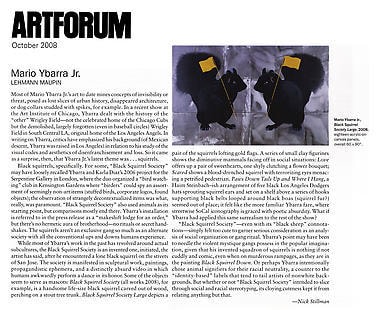
ARTFORUM
October 2008
Mario Ybarra Jr.
Lehmann Maupin
By Nick Stillman
Most of Mario Ybarra Jr.'s art to date mines concepts of invisibility or threat, posed as lost slices of urban history, disappeared architecture, or dog collars studded with spikes, for example. In a recent show at the Art Institute of Chicago, Ybarra dealt with the history of the "other" Wrigley Field - not the celebrated home of the Chicago Cubs but the demolished, largely forgotten (even in baseball circles) Wrigley Field in South Central LA, original home of the Los Angeles Angels. In writing on Ybarra, critics have emphasized his background (of Mexican descent, Ybarra was raised in Los Angeles) in relation to his study of the visual codes and aesthetics of disenfranchisement and loss. So it came as a surprise, then, that Ybarra Jr.'s latest theme was ... squirrels.
Black squirrels, specifically. For some, "Black Squirrel Society" may have loosely recalled Ybarra and Karla Diaz's 2006 project for the Serpentine Gallery in London, where the duo organized a "bird watching" club in Kensington Gardens where "birders" could spy an assortment of seemingly non-art items (stuffed birds, corporate logos, found objects); the observation of strangely de-contextualized items was what, really, was paramount. "Black Squirrel Society" also used animals as its starting point, but comparisons mostly end there. Ybarra's installation is referred to in the press release as a "makeshift lodge for an order," but there's no hermetic aura of brotherhood - no rituals or secret handshakes. The squirrels aren't an exclusive gang so much as an alternate society with all the conventional ups and downs humans experience.
While most of Ybarra's work in the past has revolved around actual subcultures, the Black Squirrel Society is an invented one, initiated, the artist has said, after he encountered a lone black squirrel on the streets of San Jose. The society is manifested in sculptural work, paintings, propagandistic ephemera, and a distinctly absurd video in which humans awkwardly perform a dance in its honor. Some of the objects seem to serve as mascots: Black Squirrel Society (all works 2008), for example, is a handsome life-size black squirrel carved out of wood, perching on a stout tree trunk. Black Squirrel Society Large depicts a pair of the squirrels lofting gold flags. A series of small clay figurines shows the diminutive mammals facing off in social situations: Love offers up a pair of sweethearts, one shyly clutching a flower bouquet; Scared shows a blood-drenched squirrel with terrorizing eyes menacing a petrified pedestrian. Paws Down Tails Up and Where I Hang, a Haim Steinbach-ish arrangement of five black Los Angeles Dodgers hats sprouting squirrel ears and set on a shelf above a series of hooks supporting black belts looped around black boas (squirrel fur?) seemed out of place; it felt like the more familiar Ybarra fare, where streetwise SoCal iconography is graced with poetic absurdity. What if Ybarra had applied this same surrealism to the rest of the show?
"Black Squirrel Society" - even with its "black sheep" connotations - simply felt too cute to garner serious consideration as an analysis of social organization or gang ritual. Ybarra's point may have been to needle the violent mystique gangs possess in the popular imagination, given that his invented squadron of squirrels is nothing if not cuddly and comic, even when on murderous rampages, as they are in the painting Black Squirrel Down. Or perhaps Ybarra intentionally chose animal signifiers for their racial neutrality, a counter to the "identity-based" labels that tend to tail artists of nonwhite backgrounds. But whether or not "Black Squirrel Society" intended to slice through social and racial stereotyping, its cloying cuteness kept it from relating anything but that.
